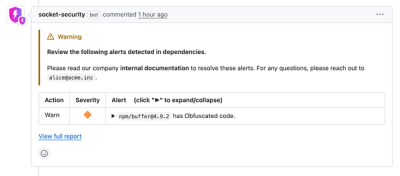
Security News
pnpm 10.16 Adds New Setting for Delayed Dependency Updates
pnpm's new minimumReleaseAge setting delays package updates to prevent supply chain attacks, with other tools like Taze and NCU following suit.
Pure Python tools for reading and writing all TIFF IFDs, sub-IFDs, and tags.
Developed by Kitware, Inc. with funding from The National Cancer Institute.
tifftools is available on PyPI and conda-forge.
To install with pip from PyPI::
pip install tifftools
To install with conda::
conda install -c conda-forge tifftools
.. highlights::
By default, tifftools does not require any external dependencies.
Note: When setting projections on TIFF files, projections that are not
specified as EPSG codes require pyproj to be interpreted correctly.
Installing tifftools[geo] will install pyproj.
tifftools --help and tifftools <command> --help provide usage details.
tifftools split [--subifds] [--overwrite] source [prefix]: split a tiff file into separate files. This is also available as the library function tifftools.tiff_split.
tifftools concat [--overwrite] source [source ...] output: merge multiple tiff files together. Alias: tifftools merge. This is also available as the library function tifftools.tiff_concat.
tifftools dump [--max MAX] [--json] source [source ...]: print information about a tiff file, including all tags, IFDs, and subIFDs. Alias: tifftool info. This is also available as the library function tifftools.tiff_dump.
tifftools set source [--overwrite] [output] [--set TAG[:DATATYPE][,<IFD-#>] VALUE] [--unset TAG:[,<IFD-#>]] [--setfrom TAG[,<IFD-#>] TIFFPATH]: modify, add, or remove tags. This is also available as the library function tifftools.tiff_set.
read_tiff
write_tiff
Constants
Tag
Datatype
get_or_create_tag
EXIFTag, GPSTag, etc.
Print information about a TIFF file:
.. code-block:: bash
tifftools dump photograph.tif
Split a TIFF file into its constituent subIFDs:
.. code-block:: bash
tifftools split --subifds photograph.tif results/
Combine multiple TIFF files into one:
.. code-block:: bash
tifftools concat photo1.tif photo2.tif photo3.tif photos.tif
Add georeferencing:
.. code-block:: bash
tifftools set aerial_imagery.tif aerial_imagery_geospatial.tif --set projection epsg:4326 --set gcps '-77.05 38.88 0 0 -77.04 38.89 100 100'
Set tags:
.. code-block:: bash
tifftools set photograph.tif photograph_tagged.tif --set ImageDescription 'Dog digging' --set Orientation '2'
Unset tags:
.. code-block:: bash
tifftools set photograph_tagged.tif photograph_untagged.tif --unset ImageDescription --unset Orientation
Copy tags from one image to another:
.. code-block:: bash
tifftools set mypic.tif mypic_tagged.tif --setfrom ImageDescription photograph_tagged.tif --setfrom Orientation photograph_tagged.tif
Print information about a TIFF file:
.. code-block:: python
import tifftools info = tifftools.tiff_dump('photograph.tif')
Split a TIFF file into its constituent subIFDs:
.. code-block:: python
import tifftools
result_dir = './results/'
tifftools.tiff_split('photograph.tif', result_dir, subifds=True)
Combine multiple TIFF files into one:
.. code-block:: python
import tifftools
inputs = ['./photo1.tif', './photo2.tif', './photo3.tif']
result_path = './photos.tif'
tifftools.tiff_concat(inputs, result_path)
Add georeferencing:
.. code-block:: python
import tifftools
projection = 'epsg:4326'
gcps = [(-77.05, 38.88, 0, 0), (-77.04, 38.89, 100, 100)]
setlist = [
('projection', projection),
('gcps', gcps),
]
# You can either use tiff_set
tifftools.tiff_set('aerial_imagery.tif', 'aerial_imagery_geospatial.tif', setlist=setlist)
# Or you can use set_projection and set_gcps
tifftools.commands.set_projection('aerial_imagery.tif', projection, output='aerial_imagery_geospatial.tif', overwrite=True)
tifftools.commands.set_gcps('aerial_imagery.tif', gcps, output='aerial_imagery_geospatial.tif', overwrite=True)
Set tags:
.. code-block:: python
import tifftools
setlist = [
('ImageDescription', 'Dog digging'),
('Orientation', '2'),
]
tifftools.tiff_set('photograph.tif', 'photograph_tagged.tif', setlist=setlist)
Unset tags:
.. code-block:: python
import tifftools
unsetlist = [
'ImageDescription',
'Orientation',
]
tifftools.tiff_set('photograph_tagged.tif', 'photograph_untagged.tif', unset=unsetlist)
Copy tags from one image to another:
.. code-block:: python
import tifftools
target = 'photograph_tagged.tif'
setfrom = [
('ImageDescription', target),
('Orientation', target),
]
tifftools.tiff_set('mypic.tif', 'mypic_tagged.tif', setfrom=setfrom)
tifftools provides a library and a command line program for maniplulating TIFF files. It can split multiple images apart, merge images together, set any tag in any IFD, and dump all IFDs and tags in a single command. It only uses python standard library modules, and is therefore widely compatible.
There was a need to combine images from multiple TIFF files without altering the image data or losing any tag information. Further, when changing tag values, it was essential that the old values were fully removed from the output.
The command line tools associated with libtiff are commonly used for similar
purposes. The libtiff command tools have significant limitations: tiffdump
and tiffinfo require multiple commands to see information from all IFDs.
tiffset does not remove data from a file; rather it appends to the file to
only reference new data, leaving the old values inside the file. tiffsplit
doesn't keep tags it doesn't recognize, losing data. tiffcp always
reencodes images and will fail for compression types it does not know.
Likewise, there is a wide variety of EXIF tools. For the most part, these only
alter tags, usually by appending to the existing file. ImageMagick's
convert command also recompresses images as it combines them.
Many programs deal with both classic and BigTIFF. Some will start writing a classic TIFF, but leave a small amount of unused space just after the file header. If the file exceeds 4Gb, parts of the file are rewritten to convert it to a BigTIFF file, leaving small amounts of abandoned data within the file.
tifftools fills this need. All tags are copied, even if unknown. Files
are always rewritten so that there is never abandoned data inside the file.
tifftools dump shows information on all IFDs and tags. Many of the command
line options are directly inspired from libtiff.
tifftools does NOT compress or decompress any image data. This is not an
image viewer. If you need to recompress an image or otherwise manipulate pixel
data, use libtiff or another library.
As an explicit example, with libtiff's tiffset, tag data just gets
dereferenced and is still in the file:
.. code-block:: bash
$ grep 'secret' photograph.tif || echo 'not present'
not present
$ tiffset -s ImageDescription "secret phrase" photograph.tif
$ tiffinfo photograph.tif | grep ImageDescription
ImageDescription: secret phrase
$ grep 'secret' photograph.tif || echo 'not present'
Binary file photograph.tif matches
$ tiffset photograph.tif -s ImageDescription "public phrase"
$ tiffinfo photograph.tif | grep ImageDescription
ImageDescription: public phrase
$ grep 'secret' photograph.tif || echo 'not present'
Binary file photograph.tif matches
Whereas, with tifftools:
.. code-block:: bash
$ grep 'secret' photograph.tif || echo 'not present'
not present
$ tifftools set -y -s ImageDescription "secret phrase" photograph.tif
$ tiffinfo photograph.tif | grep ImageDescription
ImageDescription: secret phrase
$ grep 'secret' photograph.tif || echo 'not present'
Binary file photograph.tif matches
$ tifftools set -y photograph.tif -s ImageDescription "public phrase"
$ tiffinfo photograph.tif | grep ImageDescription
ImageDescription: public phrase $ grep 'secret' photograph.tif || echo
'not present' not present
TIFF Files consist of one or more IFDs (Image File Directories). These can be located anywhere within the file, and are referenced by their absolute position within the file. IFDs can refer to image data; they can also contain a collection of metadata (for instance, EXIF or GPS data). Small data values are stored directly in the IFD. Bigger data values (such as image data, longer strings, or lists of numbers) are referenced by the IFD and are stored elsewhere in the file.
In the simple case, a TIFF file may have a list of IFDs, each one referencing the next. However, a complex TIFF file, such as those used by some Whole-Slide Image (WSI) microscopy systems, can have IFDs organized in a branching structure, where some IFDs are in a list and some reference SubIFDs with additional images.
TIFF files can have their primary data stored in either little-endian or big-endian format. Offsets to data are stored as absolute numbers inside a TIFF file. There are two variations: "classic" and "BigTIFF" which use 32-bits and 64-bits for these offsets, respectively. If the file size exceeds 4 Gb or uses 64-bit integer datatypes, it must be written as a BigTIFF.
Unknown tags that are offsets and have a datatype other than IFD or IFD8 won't
be copied properly, as it is impossible to distinguish integer data from
offsets given LONG or LONG8 datatypes. This can be remedied by defining a new
TiffConstant record which contains a bytecounts entry to instruct
whether the offsets refer to fixed length data or should get the length of data
from another tag.
Because files are ALWAYS rewritten, tifftools is slower than libtiff's
tiffset and most EXIF tools.
.. |build-status| image:: https://circleci.com/gh/DigitalSlideArchive/tifftools.png?style=shield :target: https://circleci.com/gh/DigitalSlideArchive/tifftools :alt: Build Status
.. |codecov-io| image:: https://img.shields.io/codecov/c/github/DigitalSlideArchive/tifftools.svg :target: https://codecov.io/gh/DigitalSlideArchive/tifftools :alt: codecov.io
.. |license-badge| image:: https://img.shields.io/badge/license-Apache%202-blue.svg :target: https://raw.githubusercontent.com/DigitalSlideArchive/tifftools/master/LICENSE :alt: License
.. |doi-badge| image:: https://img.shields.io/badge/DOI-10.5281%2Fzenodo.11068609-blue.svg :target: https://zenodo.org/doi/10.5281/zenodo.11068609
FAQs
Pure python tiff tools to handle all tags and IFDs.
We found that tifftools demonstrated a healthy version release cadence and project activity because the last version was released less than a year ago. It has 1 open source maintainer collaborating on the project.
Did you know?

Socket for GitHub automatically highlights issues in each pull request and monitors the health of all your open source dependencies. Discover the contents of your packages and block harmful activity before you install or update your dependencies.

Security News
pnpm's new minimumReleaseAge setting delays package updates to prevent supply chain attacks, with other tools like Taze and NCU following suit.

Security News
The Rust Security Response WG is warning of phishing emails from rustfoundation.dev targeting crates.io users.

Product
Socket now lets you customize pull request alert headers, helping security teams share clear guidance right in PRs to speed reviews and reduce back-and-forth.